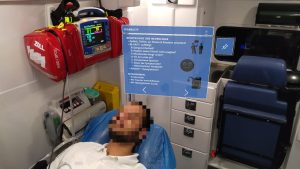Evaluating The Potential Of Integrating Augmented Reality In The Assessment Of Patients For Emergency Medical Technicians In Training
Aim and Research Question(s)
The aim of this thesis is to illustrate how the education of becoming an Austrian emergency medical technician can be improved by augmented reality (AR). Due to the fact that AR has an unlimited amount of digital possibilities, the following research questions can be derived:
- RQ#1: How can augmented reality support emergency medical technicians in the emergency medical service?
- RQ#2: To which extend is augmented reality an appropriate type of instrument for assessing patients?
Background
Trainees, at the beginning stage of becoming an EMT-B, should be prepared for saving lives and assessing the criticality of their patients within two months (260h), which is simply too little [1]. In comparison, in Germany 520 hours are needed and in the Czech Republic 700 hours [2]. EMTs have the duty to provide the best treatment for the patient as possible, which includes recognizing whether or not the patient is badly injured or has some critical diseases and if that is the case, they have to call an emergency doctor. Estimating the criticality in the wrong way could cause damage to the patient.
Methods
For answering RQ#1 a questionnaire was conducted in which the participants were asked about their expections of AR in the field of the EMS. For RQ#2 an AR prototype was developed which displays the ABCDE Scheme, an international scheme for assessing patients out of hospitals, next to a fictional patient. The trainees can then practice it live without forgetting a single step of the scheme. The following figure shows a demonstration of what a trainee would see when they wear the AR device HoloLens 2.
 Figure 1 - Projection of the D(isabilities)
A couple of EMTs tested this app and after each try-out they had to fill out another questionnaire (UEQ) which presented their attitude towards this project.
Figure 1 - Projection of the D(isabilities)
A couple of EMTs tested this app and after each try-out they had to fill out another questionnaire (UEQ) which presented their attitude towards this project.
Results and Discussion
The first questionnaire showed a lot of different use cases for augmented reality in the EMS, like a visualization of wound management. The second one reveals that an ABCDE scheme would fit into the EMT courses and would be beneficial for the education. But there exists also a minority which cannot imagine this AR App being used in their training.
Conclusion
The EMS of Austria could benefit from using augmented reality in the educational process. AR has widespread options of use cases and can be implemented quite easily and fast.
References
[1] B. Bernhard Schranz, “Risikomanagement in der österreichischen präklinischen Notfallmedizin,” 2018. [Online]. Available: https://www.oegern.at/wp/wp-content/uploads/Schranz_Masterarbeit.pdf.
[2] BVRD, “ZUKUNFT RETTUNGSDIENST - QUO VADIS, BERUFSBILD?” 2023. [Online]. Available: https://www.bvrd.at/wp-content/uploads/2023/04/Positionspapier_Zukunft_
Rettungsdienst_2023_V2.1-komprimiert.pdf
